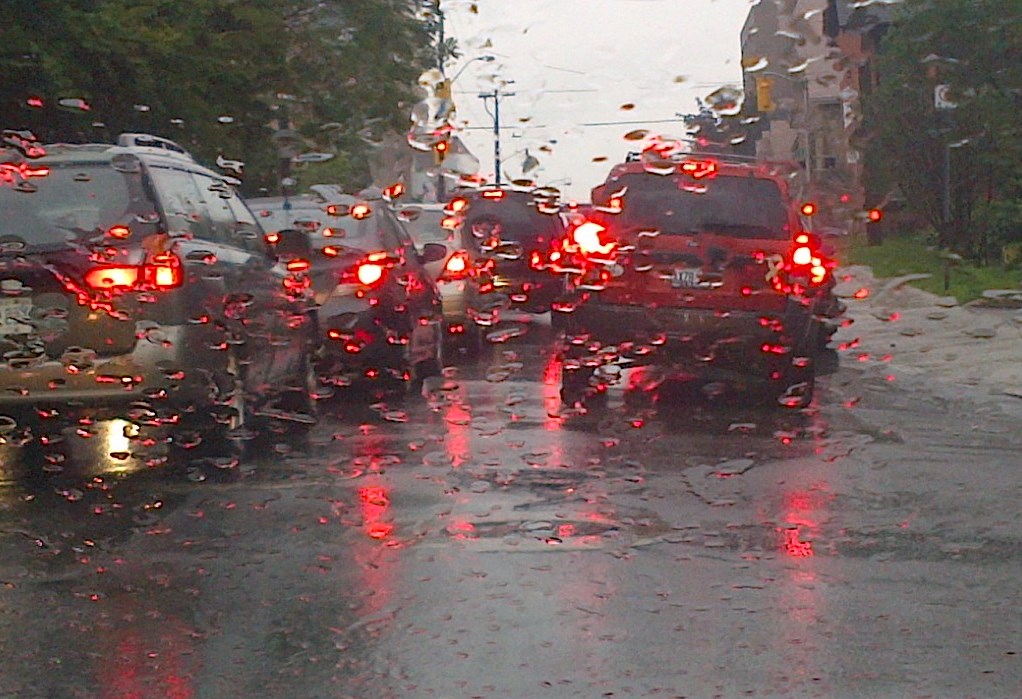When driving conditions are not ideal…
 Growing up, my parents had rules for us kids. Sit up straight, clean your room, and eat all your vegetables – just to name a few. There were things we had to figure out ourselves though without having a rule to guide us. For example, don’t wear your sandals in the snow or don’t jump out of a tree with an umbrella as it’s not a parachute. We never did those things more than once, even though they weren’t rules. The same thing can be said about driving. We shouldn’t need to have everything made into a rule to get us to stop doing them. Common sense should also be used.
Growing up, my parents had rules for us kids. Sit up straight, clean your room, and eat all your vegetables – just to name a few. There were things we had to figure out ourselves though without having a rule to guide us. For example, don’t wear your sandals in the snow or don’t jump out of a tree with an umbrella as it’s not a parachute. We never did those things more than once, even though they weren’t rules. The same thing can be said about driving. We shouldn’t need to have everything made into a rule to get us to stop doing them. Common sense should also be used.
Each time I see the road and weather conditions in less than ideal conditions, it reminds me to reduce the speed I normally drive. I need friction in order to have traction. When my friction is reduced, my traction is also reduced; simple as that. Although that may seem simple enough to a lot of drivers, many drivers seem to have a problem with this.
A heavy downpour of rain can create large puddles across the road, which can lead your vehicle to hydroplane. Hydroplaning is caused when your tires lose traction with the road surface and begin to “surf” along the top of the water. This causes you to lose steering control. Hydroplaning usually happens if you’re traveling at higher rate of speed for the road conditions and/or if you have tires with low tread. At any point in time you feel a loss of steering control, reduce speed by easing off the gas. Braking may cause additional loss of control.
 Heavy rain also reduces your visibility. Regardless of having your windshield wiper on high speed, it doesn’t mean you can still drive at posted speed limits. You should be able to see roughly 12 seconds ahead of where you currently are while driving at city speeds and roughly 20 seconds ahead of where you currently are while driving at highway speeds. If it’s raining too hard and it’s difficult to see that far ahead, slow down.
Heavy rain also reduces your visibility. Regardless of having your windshield wiper on high speed, it doesn’t mean you can still drive at posted speed limits. You should be able to see roughly 12 seconds ahead of where you currently are while driving at city speeds and roughly 20 seconds ahead of where you currently are while driving at highway speeds. If it’s raining too hard and it’s difficult to see that far ahead, slow down.
When winter conditions show up, the same things can be said. Snow, ice and slush are not ideal yet many drivers feel they can drive the same speed as if they had clear roads. Not true. Each time I ask a driver if the road conditions are ideal, they always say no. yet for some reason they drive as if the conditions are ideal. Speed limits are set for ideal conditions and if the conditions are not ideal, why drive the speed limit? It’s a maximum, not a minimum.
Increasing your following distance is always a good idea in less than ideal road conditions. This gives you more time to make a controlled stop in case the vehicle ahead stops suddenly or begins to lose control. It also help you control the driver behind you. If you don’t have to brake harsh, they won’t have to brake harsh. This can reduce multiple vehicle crashes at any time.
Driving at night is also something many drivers make errors with. On a dark roadway many drivers tend to drive at the posted speed limit…or faster. Just because it says you can drive that fast doesn’t mean you should while at night. The posted speed limit is set for ideal conditions. Driving at night isn’t ideal. Your visibility is severely reduced while at night. It’s time to reduce speed during those conditions, especially on high speed roads. This will give you more time to see, think and respond to what you may see – such as a fallen tree across your path or debris in your lane.
The bottom line is this; when conditions are not ideal, adjust to drive for those conditions. Give yourself more time to stop and more time to respond to what you see ahead of you. If you can use logic and common sense in less than ideal conditions, that would be ideal.
**Have a quick listen to this short episode of the “Speed Bumps” podcast as adjusting to conditions is discussed further!
**Also see tips for driving in the fog here.

Woow nice info.